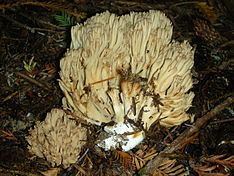Kingdom Fungi Class Agaricomycetes Rank Species | Division Basidiomycota | |
 | ||
Similar Ramaria magnipes, Ramaria araiospora, Ramaria rubripermanens, Ramaria myceliosa | ||
Ramaria acrisiccescens, commonly known as the blah coral, is a coral fungus in the family Gomphaceae. It is found in the forests of northwestern North America.
Contents
Taxonomy
The species was first described scientifically by mycologists Currie Marr and Daniel Stuntz in their 1974 monograph, "Ramaria of western Washington". The holotype was collected in 1966 about 5 miles (8.0 km) south of Elbe, Washington. It is classified in the subgenus Laeticolora. It is commonly known as the "blah coral".
Description
The fruit bodies are large, generally taller than wide, measuring 5–29 cm (2.0–11.4 in) tall by 1.5–18 cm (0.6–7.1 in) wide. The stipe, which is often deeply buried, is slender and tapered, measuring 1.5–9 cm (0.6–3.5 in) by 1–3 cm (0.4–1.2 in) wide. Fruit bodies consist of elongated branched with a roughly parallel arrangement. Each branch itself branches up to 9 times in a dichotomous fashion; each of these branches is slender, typically 1–12 mm in diameter. The branch tips are usually rounded. The context has a fleshy or fibrous consistency, but it becomes brittle and chalky when dry. The stipe of young fruit bodies is white, while the branches range from shades of grey, to beige, and even orange. The spores have colors of pale yellow and cream. The lower branches tend to bruise a brownish color. The color of the branch tips vary, ranging from more or less the same color as the branch, to pallid, or, especially in young specimens, infused with pinkish or purple tones in a small spotted transition.
The spore print is grayish-yellow. Spores are somewhat cylindrical to roughly elliptical, ornamented with lobed warts, and measure 10.1 by 4.9 μm. The basidia (spore-bearing cells) are club-shaped, one- to four-spored (although most have four), and measure 40–90 by 7–13 μm.
Habitat and distribution
Fruit bodies of Ramaria acrisiccescens grow on the ground under western hemlock, typically in mixed forests. It has been recorded from Washington and California.
